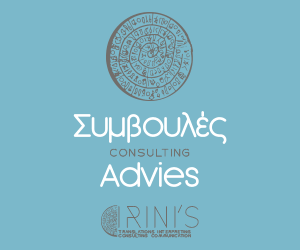This post is also available in Greek
Giannis Megalakakis is a very positive, creative and restless dancer and researcher of Cretan dances. Since childhood he has been dancing in squares and celebrations along with his twin brother. Even before adulthood he started searching, researching but also teaching the art of the Cretan dances to Greeks and people from all over the world.
Giannis, along with his ballet have already conquered the Greek stages. In 1997 they dance at the opening ceremony of the world track championships in Kallimarmaro stadium. In 2002 they participate along with their dance team at the large concert that organized in the memory of Nikos Ksilouris by the “DIFONO” magazine in the Lycabetus theater in Athens. In 2004 they dance for the opening ceremony of the Olympic games, they publish books and along with his brother they found the Center for Research and Education of Traditional Cretan Dances and never stop sharing their knowledge all over the world with people, teachers, professional dancers but also people that want to be submerged in the art of Cretan dances.
His vision is to elevate the Cretan dances into art, because that is what they deserve.
Who introduced you to dancing? How many years have you been dancing to Cretan rythmes?
My family and the way I was raised were what defined me and made me love and appreciate the Cretan dances since a young age. I am dancing for 32 years now and I still feel like I am at the start of an uphill road. A road that has given me amazing moments of expression, creation and offerings for my place. Through the dances of Crete I have known art, life, love, travels, other cultures and my inner self. Every time I dance I feel like I am transported through time and space and that my past is joined with me future.

You have stated that besides the dance steps, you tend to give a lot of focus on the history of each dance. What makes that so important for you?
Since ancient times, music in Crete had a special place. From the discoveries at the digs (Knosos, Festos, etc) and the ancient texts we can draw valuable information. Images (on pottery, ceramics, drawings) show musicians and dancers alike that are todays references. The lyricist playing in the middle while people are dancing around him in circles. There is a mysterious connection with the past, our ancestors in each corner of Crete, every time our feet are going through those steps, danced thousands of years ago by these people.

We have tracked dances and melodies that are completely unknown to most of the public. Many villages in Crete still have and dance their own dances while singing their own melodies and we have to, as teachers, to record them before they are gone for ever. From Palaia Roumata of the Chania region all the way to lower Zakro at the Lasithi region we have managed to record many dances with a lot of differences in the dance expression and attitude. We noticed that there is a difference in expression with people living in a mountain area compared to people living closer to the sea or in the flats. We see that people dance according to their experiences and way of life. The blessing here is that as long as we are searching, the more we are discovering cultural treasures that teach us ethics and inspire us to create. If you don’t feel, you don’t dance. You think you are dancing. Remembering steps is not dancing.

All of the dancers in the group are trained for years on a daily basis by us. Besides teaching the steps, my brother and I are trying to initiate people to the culture of Crete as well. We have created a dance team that doesn’t just reproduce Cretan dances but each dancer through his own psyche and personality expresses himself through them.

You are a dance teacher and a researcher of Cretan dances and along with your brother you have founded the “Center for research and teaching Cretan dances”. Tell more about the Center.
When I realised that I came into this world to dedicate myself in the art of Cretan dances a voice within me shouted and commanded me to live, to experience and feel the essence of Crete, the originality of its people, the spontaneous devotion of the Cretan soul, the machismo, the pride (not selfishness) and all those notable characteristics of the Cretans for which they have been loved by people from all over the world.
It is different to dance in order to express your self, compared with having the huge responsibility and weight of teaching others.
I remind you the words of the great American writer William Arthur Ward (1921 - 1994):
The mediocre teacher tells. The good teacher explains. The superior teacher demonstrates. The great teacher inspires.”

I had inside me the motion, the fire, the thirst to discover but it was not enough for me. So for many years now I am doing on the spot documenting at the Cretan villages, I discuss with major dancers and musicians, I study files and publications that are concerned with the Cretan civilization. I entered a sea of experiences that will never end and I feel blessed that all my energy is being directed into to something that completely expresses me.
Traditions have truth, love, passion, solidarity, art, ancient history and amazing people stories. All of the above are needed to be experienced by a dance teacher in order to shape his character through them and afterwards with a bit of dancing talent, that has to be there, he can start teaching the philosophy of the Cretan dances. Through dancing we are teaching about Crete to our students. They are initiated into the Minoan way of thinking.
At the Research Center we are collecting all of our documenting, cross check our sources and information and try to have a full course on it.

We have even published 3 works: “When I hear Crete”, “Dancing-writing” and “I dance eons in Crete”. Anyone that is working on cultural things is being judged on what legacy he will leave. How many people will he be able to inspire to follow his path. Also, through research we have managed to evolve the art of Cretan dances creating our own moves and self improvisations. Tradition is not a museum, it is something alive and that is why it has managed to be preserved for all those centuries. But, in order to advance a tradition without altering it you need research, knowledge, love and contact with the art it self.

Is there interest about traditional dancing by younger people? What do you think is the reason that younger people don’t dance.
We have to preserve a creative relationship with the past and our ancestors and by the lessons learned in that experience, proceed for the future. We have complete many Cretan dance seminars in many areas of Greece but also abroad. Within our world tour, which its main goal is to bring the music and dancing of Crete everywhere, we are also doing Cretan dance seminar working with cultural organizations that have common goals and vision. Young people love traditional dancing and have a thirst for knowledge, inspiration, emotion. My vision is to create a institution that will develop traditional dance teachers. In ballet, latin, flamenco and tango you receive a degree in order to become a dance teacher, that is not the same with traditional dances - when in fact historically some of the first dancers were Greek. Being a dancer is different than being a dance teacher. It is different to dance because I like it and different to teach and transfer my culture and civilization through dancing to the new generation. When I teach I feel awe, I feel weight. The concept of the dance teacher is a heavy one.

What is a lesson by Giannis Megalakakis like?
I give great importance in the process that comes before teaching dance steps, which is to explain and analyse from which area is the music we are about to hear and dance to, whose Mantinada is it, and who is the singer. It is very important to know what you are dancing to.

My vision as a dance - teacher is to get my students to know and love Crete. I teach over 20 Cretan dances that cover geographically the entire Crete, alterations of the dances, a lot of dance moves and improvisations and the way to create those. My goal is to touch and inspire my students no matter what their dance level or origin may be. To make them realise the exciting feeling of creating through the Cretan dances. I am not interested to just teach a few steps but to make the feel the gravitas and the true dimension of art and history related with the Cretan dances.

You just came to stay in the Netherlands for a year. What are your plans?
For many years now I have been traveling all over the world to elevate the Cretan dance expression. Now I am in the Netherlands, in the center of European culture. My vision is to transmit and project the history and the art of Cretan dancing in the whole world.
My proposal goes out to cultural institutions - clubs - dance schools - dance teams that want to learn more about the art and history of Cretan dancing.

To be more specific, the candidates for training can be:
a. Students of any age - nationality - dance level of Cretan dances, but also with knowledge (in an amateur or professional level) on other kinds of dancing.
b. Dance teachers with knowledge and specialization in any kind of dance or dances (greek, european, latin, etc). The goal is to create knowledgeable and inspired teachers that will transmit their knowledge to their countries of origin. The purpose is to upgrade the art of the Cretan dance in a global level.

Along with your team you have danced in ceremonies of big events one of which is the ending of the Olympic Games (2004), at Kallimarmaro stadium, you have taken up teaching Cretan dances for the Greek drama series “The Island” and many other interesting things. What is the next thing in mind for you to do?
The moments I’ve lived are unique and are facts that will remain for ever in my heart. I wish for every person to experience moments like these. That is the way to give meaning and value in life. The team started in 1998. After many years of quality shows, seminars and special events, we want to proceed into the next years with our goal being to give a different course for the art of Cretan dancing.
We fully believe that the tradition has been preserved up to today because it managed to evolve on the needs of each time. We feel that if that is not accomplished then we will be only talking about a museum tradition that cannot stand on modern requirements.

We have seen eye to eye in dance shows with other kind of dances, we presented the art of Cretan dances through music scenes.
The vision of our team is to transmit and show the history and art of Cretan dancing in all of the world with shows using todays mediums and techniques but based deeply in our history.
Learn more about Giannis Megalakakis at www.megalakakis.gr
You can listen (in greek), the interview of Giannis MEgalakakis at the greek radio show Hellas Pindakaas, at Salto Wereld FM, HERE.













